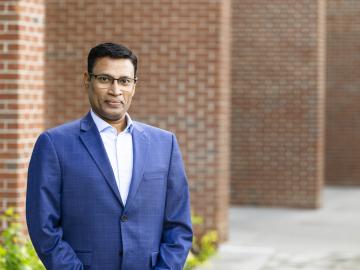
Filter News
Area of Research
- Advanced Manufacturing (1)
- Biology and Environment (13)
- Computational Engineering (1)
- Computer Science (4)
- Energy Science (16)
- Fuel Cycle Science and Technology (1)
- Fusion and Fission (6)
- Fusion Energy (7)
- Isotopes (1)
- Materials (9)
- Materials for Computing (1)
- National Security (40)
- Neutron Science (5)
- Nuclear Science and Technology (11)
- Nuclear Systems Modeling, Simulation and Validation (1)
- Supercomputing (30)
News Topics
- (-) Advanced Reactors (40)
- (-) Big Data (79)
- (-) National Security (86)
- 3-D Printing/Advanced Manufacturing (147)
- Artificial Intelligence (131)
- Bioenergy (112)
- Biology (128)
- Biomedical (73)
- Biotechnology (39)
- Buildings (74)
- Chemical Sciences (86)
- Clean Water (33)
- Composites (35)
- Computer Science (226)
- Coronavirus (48)
- Critical Materials (29)
- Cybersecurity (35)
- Education (5)
- Element Discovery (1)
- Emergency (4)
- Energy Storage (114)
- Environment (218)
- Exascale Computing (67)
- Fossil Energy (8)
- Frontier (64)
- Fusion (67)
- Grid (74)
- High-Performance Computing (130)
- Hydropower (12)
- Irradiation (3)
- Isotopes (62)
- ITER (9)
- Machine Learning (68)
- Materials (157)
- Materials Science (158)
- Mathematics (12)
- Mercury (12)
- Microelectronics (4)
- Microscopy (56)
- Molten Salt (10)
- Nanotechnology (64)
- Neutron Science (171)
- Nuclear Energy (122)
- Partnerships (68)
- Physics (69)
- Polymers (35)
- Quantum Computing (53)
- Quantum Science (93)
- Security (31)
- Simulation (65)
- Software (1)
- Space Exploration (26)
- Statistics (4)
- Summit (71)
- Transportation (103)
Media Contacts

From decoding plant genomes to modeling microbial behavior, computational biologist Priya Ranjan builds computational tools that turn extensive biological datasets into real-world insights. These tools transform the way scientists ask and answer complex biological questions that advance biotechnology breakthroughs and support cultivation of better crops for energy and food security.

Analyzing massive datasets from nuclear physics experiments can take hours or days to process, but researchers are working to radically reduce that time to mere seconds using special software being developed at the Department of Energy’s Lawrence Berkeley and Oak Ridge national laboratories.

The University of Oklahoma and Oak Ridge National Laboratory, the Department of Energy’s largest multi-program science and energy laboratory, have entered a strategic collaboration to establish a cutting-edge additive manufacturing center.
Daniel Jacobson, distinguished research scientist in the Biosciences Division at ORNL, has been elected a Fellow of the American Institute for Medical and Biological Engineering, or AIMBE, for his achievements in computational biology.
Dave Weston studies how microorganisms influence plant health and stress tolerance, using the Advanced Plant Phenotyping Laboratory to accelerate research on plant-microbe interactions and develop resilient crops for advanced fuels, chemicals and

In collaboration with the U.S. Department of Homeland Security’s Science and Technology Directorate, researchers at ORNL are evaluating technology to detect compounds emitted by pathogens and pests in agricultural products at the nation’s border.
Scientists at ORNL have developed a method that can track chemical changes in molten salt in real time — helping to pave the way for the deployment of molten salt reactors for energy production.
Training nuclear safety experts to measure the unseen: ORNL’s course enhances nuclear accountability
Professionals from government and industry gathered at ORNL for the Nondestructive Assay Holdup Measurements Training Course for Nuclear Criticality Safety, a hands-on training in nondestructive assay, a technique for detecting and quantifying holdup without disturbing operations.

During his first visit to Oak Ridge National Laboratory, Energy Secretary Chris Wright compared the urgency of the Lab’s World War II beginnings to today’s global race to lead in artificial intelligence, calling for a “Manhattan Project 2.”

Not only did ORNL take home top honors at the 2024 International Conference for High Performance Computing, Networking, Storage, and Analysis (SC24), but the lab’s computing staff also shared career advice and expertise with students eager to enter the world of supercomputing.


